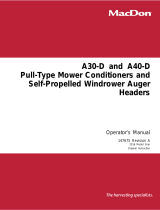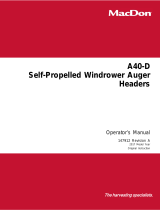Page is loading ...

1
Tsubaki
Cableveyor®
1 Construction/Part Names
2 Installing Dividers
Dividers are installed when inserting cables and hoses.
Follow the steps below with the arms opened (only the lock stays attached) and install the vertical dividers onto the inner
circumference of the lock stays.
1) Hook the catching part on one side of the divider to the
lock stay.
2) With the catching part hooked, push the catching part
on the other side of the divider onto the lock stay to
install.
There are two types of vertical dividers
STAS
Sliding divider for DSA
STAL
Locking divider for DSA
Note: Dividers are installed every 2 links. Check the amount that is installed in any one location.
Installing vertical dividers continuously onto neighboring lock stays will cause interference when the Cableveyor
bends. Ensure there is 2 or more links of space (in the direction of the pitch) between dividers.
Instruction Manual
Identifying hole (1)
Identifying hole (2)
TKR20H28
Plastic Travel End Bracket
Arm
Horizontal Divider
Vertical Divider
(STAS or STAL)
Link
Lock Stay
Fixed End Bracket

2
3 Attaching Arms
1) Push the arm down in the direction of the arrow and attach to the link. 2) Ensure that it is firmly attached.
4 Removing Arms
1) Insert a flat head screwdriver into
the space between the arm and the
lock to release the lock.
Caution: Gently lift up the screwdriver
if the arm does not release
and lift up.
Caution: Forcing the screwdriver into
the space may damage the
link bar.
2) Open the arm and rotate until it is
directly vertical.
3) Pull the arm laterally to remove.
Note: Use a screwdriver with a 4mm or smaller tip.
5 Removing Lock Stays
1) Insert a flat head screwdriver into
the indentation on the lock stay and
twist lightly to slightly lift up the lock
stay.
Caution: Using excessive force may
break the lock stay and
cause it to fly apart.
2) Repeat 1) on the other side of the
link (along the length of the lock
stay) to lift the lock stay up fully.
3) Remove the lock stay by hand.
Note: Use a screwdriver with a 4mm or smaller tip.

3
6 Connecting Cableveyors and Brackets
Long length formations (over 100 links) are generally shipped disassembled. Connect the Cableveyor as follows.
Refer to the previous sections for removing arms and lock stays. Brackets are attached in the same way.
1) Remove 5 or more arms and lock
stays on each end and align the
links.
2) Insert the protrusion on top of the
link into the indentation on the
adjacent link.
3) Attach the bottom side of the link.
Magnified view Magnified view Magnified view
4) Repeat the process on the other side. Reattach the arms and lock stays.
7 Disassembling Cableveyors and Removing Brackets
Disassemble the Cableveyor to the required length as follows. The following applies to removing brackets as well.
1) Remove the arms and lock stays from 5 or more
links on both ends of the area you wish to
disassemble, and insert a flat head screwdriver
into the hole on the bottom (inner circumference)
of the link.
2) Twist the screwdriver in the direction of the arrow to remove
the link.
Note: Use a screwdriver with a 4mm or smaller tip.
8 Attaching Lock Stays
Attach lock stays as follows.
1) Align the link protrusions and the
indentations of the lock stay
horizontally at a 45º angle.
2) Hold the lock stay by its center
and rotate.
3) Press down on the lock stay on
both sides near the center to
attach the lock stay.
Note: 1. Ensure that the lock stay is firmly attached to the link stay.
The lock stay may come loose and fall off during operation if not firmly attached.
2. When using vertical dividers, ensure that the lock stay is firmly attached to the link stay after attaching the divider.
3. The lock stay may lift up as shown in photos 1 and 2 below if it is not properly attached. Please use caution.

4
9 Caution
Depending on the application, pretension and sag may appear in the free span. However, if selected within Tsubaki’s
performance graph then there will be no problems with use.
Any unevenness on the plastic bracket installation surface may damage the bracket. Ensure that the installation
surface is as smooth as possible. Over-tightening the installation bolts can also damage the plastic bracket. Please
use the following recommended tightening torque.
Bolt Size Recommended Tightening Torque
M4 0.6 N/m
No.UM01770 Issued May, 2013 ©Tsubakimoto Chain Co.
1. Machine travel end installation height (H’) should be
Cableveyor height H + (10-30).
2. Cableveyor space height (h) is H + 100.
3. Install a guide rail.
4. The difference (ε) in the travel end and fixed end
bracket attachment sides should be less than 4mm.
5. Use travel cables/hoses with excellent bending and
wear properties.
6. Avoid using cables/hoses with wire braiding, as they
are easily damaged.
7. Cables/hoses wear easily when used stacked onto
of one another. Lay horizontally or use horizontal
dividers.
8. Set cables and hoses in the Cableveyor so that
they have some play, and clamp both ends.
9. Remove foreign objects from guide rails, as they
may cause damage.
10. Dividers are shipped unassembled and will require
assembly when installing the Cableveyor.
Not properly attached
(outer side)
Properly
attached
Photo 1
Not properly attached
(inner side)
Photo 2
Lifting up Properly
attached
Lifting up
Guide Rail
/



















